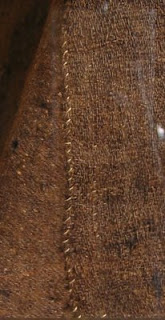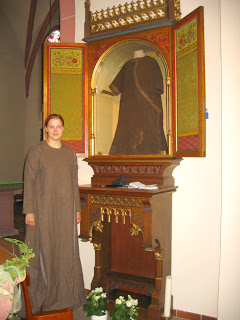Teffania came up with questions on yesterday's post, and to avoid getting lost in comments, here are the answers.
So is this seam similar to the way some of the hose in the museum of London "textiles & clothing" book are constructed? (except the hose has running and overcast/whip stitch).
This method is near impossible to do by machine, but I've actually made a pair of hose with both sides in overcast stitch by mistake. I noticed that my fabric frayed less if my stitches were perpendicular to the seam on the cut side and diagonal on the other side. The opposite appears to be true of the stitching in your photo. (but then again, my fabric had more fabric than I'd prefer, and was on the very curved portions of the hose foot.
Yes, the hose in some of the London finds have the same seam in the foot parts, where it is most important to have flat seams.
Regarding the machine sewing, I would say it is absolutely impossible to do that seam on a machine, since you can't get proper overcast stitching. And I'm a handsewing advocate for medieval garments anyways, because you just get a different result. Especially when overcast seams come into play!
Anyway, while sewing this I found the easiest way to sew was to sew one side, then turn over and sew the other side. (Always sewing on the side with the cut edge visible).
Yes. Frankly I don't remember ever trying to sew from the other side, but since you don't see the edge, it would be incredibly hard and time-consuming. And medieval crafts may be time-consuming, but they are also very, very efficient.
My normal, don't think, do-them-fast overcast stitches are diagonal on the outside, and that's why they are diagonal on the gowns as well. And they are on the original. I don't know anyone who does perpendicular overcast as the standard (that would mean conducting the needle diagonally through the fabric, which is not the easiest way, especially when hem-stitching).
I notice in the photo that the stitches are prominent on the cut edge, but much less so for the other line of stitching. Do you think this is evidence for this garment being sewn this way? Did you get to see the other side of the garment? Did the seams look the same from the other side?
Yes, the stitches can only be seen on the outer side. I did not see the inner side of the garment, but on my hand-sewn gowns, you see one line of stitches on the outside and two lines of stitches on the inside. Why? Because it's so much faster.
I start sewing the outside line. When doing this, I have to align the two cut edges so I get an even overlapping, about 5 mm wide. This takes time (and sometimes nerves, when the overlap somehow sneaks away, and I have to re-sew a couple of centimeters).
Then I turn the half-finished garment around and sew the other side. Now I don't want the stitches from the inside to be visible on the outside, so it is actually a hem stitch and not a simple overcast stitch. Since doing the hem stitch means only catching one or two fabric threads instead of just ramming that needle through, this is also taking concentration.
Doing the seam that way means I have to concentrate only on the overlap while doing the outer edge, and only on the stitches while doing the inner edge. The other way around, I have one no-brainer (the outer edge) and one double-concentration-stint (the inner edge). And I'll still end up with a less-than-perfect outer seam, because even if you really really concentrate, there will be some wiggling of the second seam (because of that tendency of the overlap to sneak away).
This seam type doesn't seem as strong as some types to me - the edge is exposed to fraying, (unless it fulls a lot which I can't see in the photo) and the stitches can pull out by fraying the fabric. Are the high stress areas (eg armholes) constructed in the same way? How do these seams stand up to wear and tear in your recreations?
This very, very much depends on your fabric. And your sewing, of course. When I did my first copy, I did not know much about these seam types. I had an unfulled fabric, and I made very large, very wide-spaced stitches.
Seeing the original dress was an eye-opener for me. These stitches are tiny, and they are very closely spaced. I tried that version, and to my surprise, there is no fraying.
I would say that putting stitches in closely protects the cut edge, so it can't fray (or at least not much). Because it can't fray and more importantly, because you have overcast both edges onto the fabric of the counterpart panel, there is no stress on the cut edge. It is somehow hard to grasp for the modern mind, but it really works. You need to have closely spaced small stitches however, or there are not enough "anchor points" for the seam on the inside of the dress (only hem stitches, remember?).
The seams stand wear and tear with no problem. There are one or two places at one of the dresses where a few threads have moved away from the cut edge, but only a centimeter or so in length. There is a lot of fulling in the underarm region, but the seams are stronger than you'd think.
Finally, if the garment has some badly reconstructed bits, how many seams are original?
The seams attaching the sleeve to the body, the seams on the sleeve side of the body. The shoulder seams. Those running diagonally across the body were probably put in to compact the dress after lots had been cut away, and my guess is that these parts are remnants of the gores from the left side of the garment.
I hope this was helpful!






